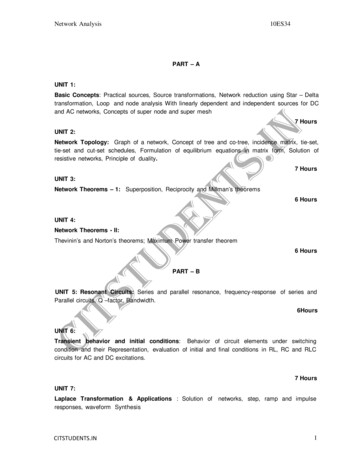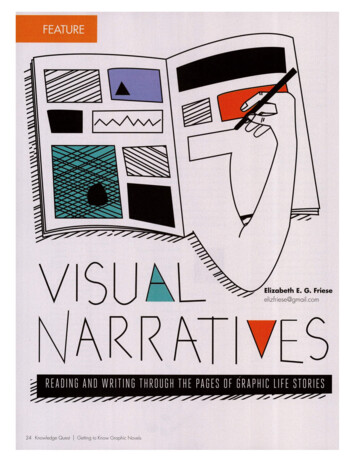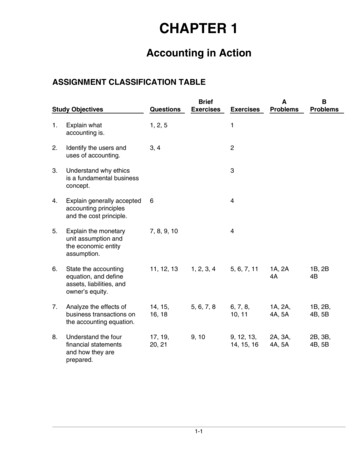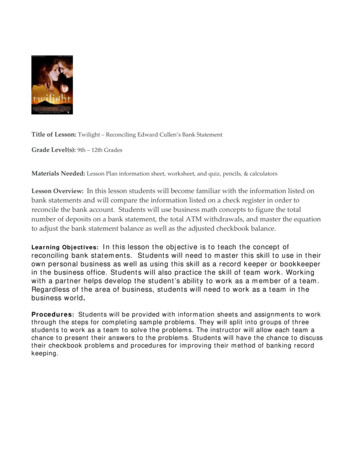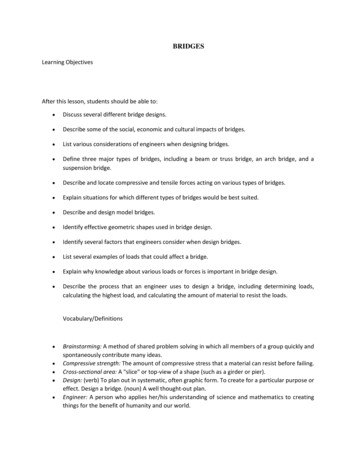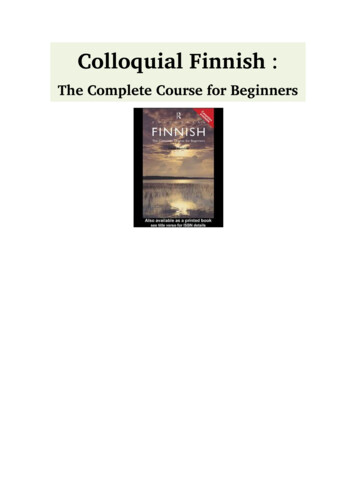
Transcription
Colloquial Finnish :The Complete Course for Beginners
title:authorpublisherisbn10 asinprint isbn13ebook isbn13language::::::subjectpublication datelccddc:::subject:Colloquial Finnish : The Complete Course forBeginners The Colloquial SeriesAbondolo, Daniel Mario.Taylor & Francis shFinnish language--Spoken Finnish, Finnishlanguage--Textbooks for foreign speakers-English.1998PH135.A26 1998eb494/.54183421Finnish language--Spoken Finnish, Finnishlanguage--Textbooks for foreign speakers-English.Page iColloquial FinnishPage iiThe Colloquial SeriesThe followinglanguages are availablein the Colloquialseries:AlbanianAmharicArabic (Levantine)Arabic of EgyptArabic of the Gulf andSaudi ArabiaBasqueBulgarian* Cambodian* Cantonese* * ianPolishPortugueseRomanian* RussianSerbo-CroatSlovakSloveneSomali* SpanishSpanish of LatinAmericaSwedish* ThaiTurkishUkrainian* VietnameseWelshAccompanyingcassette(s) are availablefor the above titles.Accompanying CDs*are also available.
Page iiiColloquial FinnishThe Complete Course for BeginnersDaniel Abondolowith dialogues by Hanna Björklund and Elina MultanenLondon and New YorkPage ivFirst published 1998by Routledge11 New Fetter Lane, London EC4P 4EEThis edition published in the Taylor & Francis e-Library, 2003.Simultaneously published in the USA and Canadaby Routledge29 West 35th Street, New York, NY 10001 1998 Daniel AbondoloAll rights reserved. No part of this book may be reprinted or reproducedor utilized in any form or by any electronic, mechanical, or other means,now known or hereafter invented, including photocopying and recording,or in any information storage or retrieval system, without permission inwriting from the publishers.British Library Cataloguing in Publication DataA catalogue record for this book is available from the British LibraryLibrary of Congress Cataloging in Publication DataAbondolo, Daniel MarioColloquial Finnish: the complete language course/DanielAbondolo.p. cm.—(The colloquial series)ISBN 0-415-11391-1 (pack).—ISBN 0-415-11389-X (pbk).—ISBN 0-415-11390-3 (audio cassettes)1. Finnish language-Spoken Finnish. 2. Finnish language-Textbooksfor foreign speakers-English. I. Title. II. Series.PH135.A26 1997494'. 54183421–dc20 96–32137CIPISBN 0-203-13287-4 Master e-book ISBNISBN 0-203-29609-5 (OEB Format)ISBN 0-415-11389-X (Print Edition) (book)ISBN 0-415-11390-3 (Print Edition) (cassette)ISBN 0-415-11391-1 (Print Edition) (book and cassette course)
ContentsAcknowledgementsList of abbreviations and symbolsAbout this bookThe sounds of Finnish1 Tutustutaan Making contact2 Ei, kiitos! No thanks3 Ole hyvä! Help yourself!4 Paikasta toiseen Getting around and about5 Mitä me ostetaan? What‘ll we buy?6 Mennääks kiskalle! Let‘s go to the kiosk!7 Eiks ookki ihana päästä kotiin joulunviettoon! Isn‘t it great to get home for Christmas!8 Huonosta vielä huonommaksi From bad to worse9 Aika ja tila Time and space10 Mitä tehtäs tänään? What‘ll we do today?111213141516Yhä nopeammin More and more quicklyMaton alla tuntuu olevan jotain There seems to be something under the carpetMikä laulaen tulee Easy come Karhut voi kai olla vaarallisiakin Bears can be dangerous, I supposeVakavia asioita Serious mattersÄlköön sanottako! Let it not be said!Key to exercisesAppendix: Finnish namesFinnish-English glossaryEnglish-Finnish glossaryGlossary of grammatical 22237252267277279292300305
AcknowledgementsI wish to thank the following people for much help I have received during thepreparation of this book. Among the many native speakers who have helped me,Hanna Björklund and Elina Multanen deserve special mention: it is they whoprovided most of the dialogue materials, on which the grammar sections are largelybased, and with whom I have had many profitable discussions over points ofsuitability and style. Other native speakers who have helped me over the years areMatti Koskiala, Heikki and Eeva Sarmanto, and, most recently, Tuomo Lahdelma. Ialso thank the numerous teachers of Finnish who have helped me, first and foremostAili Flint, who is a language-teaching paragon, but also Eila Hämäläinen and FredKarlsson, Hannele Branch, Carol Rounds, and Sirkka Betts. This is also the place toexpress my gratitude to those colleagues, conversant with both language-teachingand with Finnish, who made valuable suggestions, namely Stefan Pugh, Ian Press,and Peter Sherwood; to the superb copy-editing of Jenny Potts; and to Simon Bell,Kate Hopgood, and the rest of the editorial team at Routledge for getting the bookstarted and through various hurdles.
Abbreviations and symbolsAbbreviationsThe names of the cases are always abbreviated with uppercase letters, as nativePartitiveTranslativeSingular and plural are indicated by a preposed lowercase s or p, e.g. sG genitivesingular, pILL plural illative.The codes s1 s2 s3 p1 p2 p3 refer to first, second, and third persons singular andplural.Other cipial constructionpresentpastparticipleExamples:s1 pt first person singular past, e.g. mä men i n ‘I went’.s2second person singular form of plural inessive, e.g.pIne tasku i ssa si ‘in your pockets’. previous pagepage ixnext page previous pagepage xnext page Page xSymbols (upright line) is used to separate the morphemes, i.e. the minimalmeaningful units of words, e.g. English tree s, friend li ness,Finnish puu t, ystävä llis yys.Qis found at the ends of morphemes, and stands for a variety ofphonetic and grammatical effects: see Unit 2.Xsee Q.
stands for ‗changes to‘ or ‗is read as‘, e.g. pp p is ‗pp changes top‘. previous pagepage xnext page previous pagepage 1next page Page 1About this bookThis book aims to provide you with the basics you need to communicate in Finnish.That means grammatical nuts-and-bolts, some useful vocabulary, and an idea ofhow to guess at the meanings of words you haven‘t heard before. It is not a phrasebook or a tourist‘s guide to Finland; plenty of those are already available, andbesides, all the phrase-books in the world won‘t get you communicating if youaren‘t equipped with the rules.Finnish is the first language of some five and a half million people. Most speakerslive in Finland, but there are also significant enclaves in Sweden, Estonia, andNorway, and in the area around Lakes Michigan and Superior in the United Statesand Canada.In the European context, Finland presents a rich paradox: geographically northern, itis culturally like neither Sweden nor Norway; geographically eastern, it is likeneither Poland nor Ukraine. The main reason for this uniqueness is Finnish culture,borne and permeated by the Finnish language.Neither Germanic (like Swedish, German, or English) nor Slavonic (like Polish andUkrainian), Finnish is a Uralic language, and is thus related to Estonian, Saam(Lappish), and (much more distantly) to Hungarian. Most of Finnish vocabulary willtherefore probably be new to you; the learning curve flattens out fairly soon,however, because once you enter the intermediate stages you will find Finnishvocabulary richly systematic and therefore relatively easy to learn.Some of the grammar, too, is quite different from that of most European languages.But there is nothing intrinsically difficult about it; it is simply unfamiliar. We‘ll hit afew of the high spots here to give you some idea of what‘s in store.Finnish pronunciation presents few novel challenges, and the spelling is for the mostpart perfectly consistent. For English previous pagepage 1next page previous pagepage 2next page
Page 2 previous page previous pagepage 2page 3next page next page Page 3speakers, there are few unfamiliar sounds. Many will be relieved to learn thatFinnish word-stress is always on first syllable.Finnish words take on many forms, and some Finns like to try to frighten foreignerswith tales of sesquipedalian (i.e. polysyllabic) adjectives and case systems withfifteen-plus members. And in fact, Finnish nouns can and do take some fifteendifferent endings depending on their role in the sentence. The word for ‗Finland‘,for example, Suomi, can also be Suomesta, Suomeen, and Suomessa,
corresponding to English ‗from Finland‘, ‗to Finland‘, and ‗in Finland‘. But nothingas complicated as Latin or even Russian or German need be feared, for the endings,or suffixes, which appear at the end of this word (and which we shall segment inthis book as Suome sta, Suome en, Suome ssa) are essentially the same for allnouns, in both singular and plural. There is no grammatical gender, even in the thirdperson singular pronoun: Finnish does not distinguish ‗she‘ from ‗he‘, or ‗her‘ from‗him‘. The Finnish verb is also quite straightforward, particularly when comparedwith that of English, French, or Spanish. There is only one irregular verb (or oneand-a-half).The Finnish lexicon is exceptionally rich, in part because of the built-in machinerywhich the language has for making and modifying words, in part because of itsopenness to foreign borrowings and the creativeness of its slang. If you areinterested in folk poetry, you probably already know that Finnish is the key to theworld‘s largest archive of orally transmitted verbal art.It is perhaps useful to stress that like any language, Finnish is more than a means ofcommunication. It is also an object which can be studied for its own sake. You don‘tneed to devote the rest of your life to studying it, but the more thought and work youinvest into Finnish itself, the more communication will become not only easier butmore pleasurable. previous page previous pagepage 3page 4next page next page Page 4The sounds of FinnishThe basic rule for good pronunciation of Finnish is: don‘t rush; give all the soundstheir due time and attention.VowelsThe letters i e a o u y ä ö stand for sounds which are always pronounced fairlyshort, but never mumbled or clipped, regardless of position. Always long are thesounds written ii ee aa oo uu yy ää öö, i.e. the same eight letters doubled.The vowels may be classified roughly according to their manner of articulation ashigh (i y u), mid (e ö o), and low (ä a); front (i y e ö ä) vs. back (u o a); androunded (y ö u o) vs. unrounded (i e ä a).Listen to the recording and do your best to imitate these samples, concentrating onthe vowel marked with italics. Remember to stress the first syllable, regardless ofwhat else is going on later on the word.FinnishMeaningPronounced as inGermanPronounced a bit as inEnglish
i kiva‗bit‘ (especiallyAustralian)‗bead‘‗cook‘ (especiallyAustralian)(billed and) ‗cooed‘––‗square‘, but with notrace of an ‘r’smashing bitteii kiitos thanksu kuva picturebieteguckeuukuuma hoty kylä villageyy tyyli styleee veteen into thewaterSchuheHüttemüdegäbe previous pagepage 4next page previous pagepage 5next page Page 5ootaloon‗north‘, but with notrace of an‘r’Höhle –into the house ohneöökeittiööninto thekitchenaapataan into the potääpesään into the nestroade keliconditions(placename)o Kolikeelö kölifisha kalahandä käsiAhnung‗palm‘–‗ban‘, but m,‘ but shorter‗bat‘The letter-sequences ie, uo, yö represent diphthongs. You may first attempt them bysimply pronouncing a good Finnish i, u, or y followed by a good Finnish e, o, or ö.Avoid allowing the diphthong to ‗centre‘, i.e. do not pronounce (as in Leeds or NewYork ‗near‘, ‗cure‘) the second vowel as a schwa (like the second vowel in ‗sofa‘).Avoid, also, the temptation to lengthen the second vowel at the expense of the first(as in Italian miele, buono).ie kieliuo Suomiyö syödälanguageFinlandto eat– cf. Jamaican ‗face‘– cf. Jamaican ‗goat‘––Here are some more examples to practise. Make sure you can clearly hear thedifference in length (of the vowels, again, in italics):EnglishPigof a rowof a hherringinto a rowinto a nameContrasti : iii : iie : ee
of a fishof a poemof sorrowexpensessummer unoonsuruunkuulutröökiryyppyinto a fishinto a poeminto sorrowyou belongfag, cigarette(alcoholic) drinka : aao : oou : uuu : uuö : ööy : yyConsonantsMost of the consonants also come in short and long varieties. Between vowels, thelong consonants are written double. For example: previous pagepage 5next page previous pagepage 6next page Page ay Daycash registerbeenkukkamattovappukassaollutWhen two different consonants occur next to one another, either the first or thesecond is long. Length is indicated in spelling as follows.1 If the first consonant is pronounced short and the second consonant is pronouncedlong, the second consonant is written double. d (sP)mapdomesticated tenteasymarchfloppy disksensitive, touchysalary2 In the reverse scenario, that is, if the first consonant is pronounced long and thesecond is pronounced short, both consonants are written single. Practise �halpahourelephantbackwoodsselfcoughcheap
Special attention should be paid to the following letters:hrepresents a sound much like English ‗h‘ in ‗hut‘, except whenwritten to the left of another consonant letter, when it represents avoiceless velar fricative (as in German Bach) or a voicelesspalatal fricative (as in German ich), depending, as in German, onthe surrounding vowels. Listen to these words and try to copy jägiraffekirahvi previous
title : Colloquial Finnish : The Complete Course for Beginners The Colloquial Series author : Abondolo, Daniel Mario. publisher Taylor & Francis Routledge: isbn10 asin 041511389X: print isbn13 : 9780415113892 ebook isbn13 : 9780203132876 language English: subject

